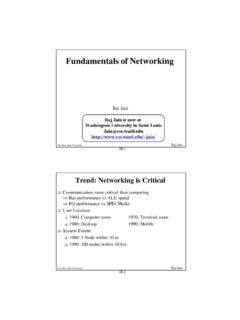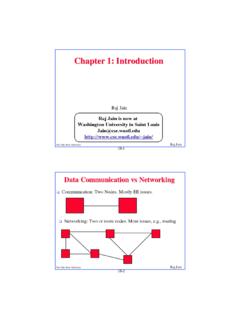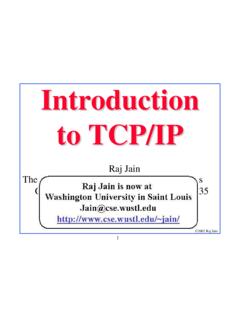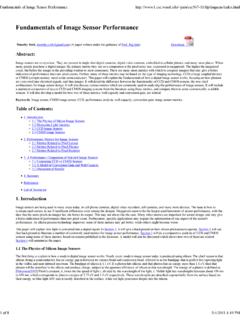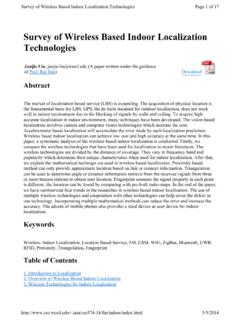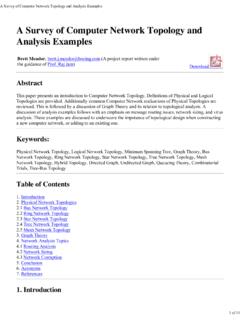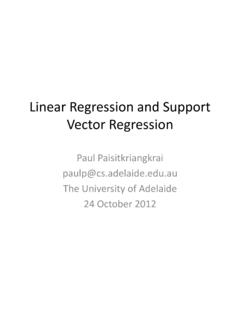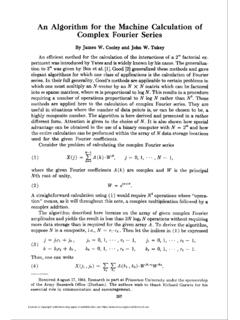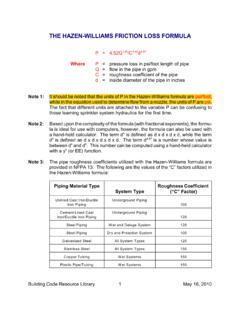Transcription of Channel Models A Tutorial - Washington University in St. Louis
1 Channel Models A Tutorial1 February 21, 2007 Please send comments/corrections/feedback to Raj Jain, Please send comments to 1 This work was sponsored in part by WiMAX Forum. Page 2 of 21 V1 Created on 2/21/20072 Channel Models : A TutorialTABLE CONTENTS Channel Models : A Channel Models : A BASIC Channel ..3 Path loss ..4 Shadowing ..4 Multipath ..5 Tapped Delay Line Model ..7 Doppler Spread ..7 EMPIRICAL PATH loss Hata COST 231 Extension to Hata Model ..9 COST 231-Walfish-Ikegami Model ..9 Erceg Model ..12 Stanford University Interim (SUI) Channel Models ..14 ITU Path loss Models ..18 REFERENCES ..21 Table of Figures FIGURE : Channel 3 FIGURE : PATH loss , SHADOWING, AND MULTIPATH [GOLDSMITH2005] 6 FIGURE : SHADOWING 5 FIGURE : MULTIPATH 5 FIGURE : MULTIPATH POWER DELAY PROFILE 6 FIGURE : TAPPED DELAY LINE MODEL 7 FIGURE : PARAMETERS OF THE COST-231 W-I MODEL [MOLISCH2005] 10 FIGURE : STREET ORIENTATION ANGLE [CICHON] 11 FIGURE : GENERIC STRUCTURE OF SUI Channel Models 15 List of Tables TABLE : TYPICAL DOPPLER SPREADS AND COHERENCE TIMES FOR WIMAX [ANDREWS2007] 8 TABLE : PARAMETERS OF THE ERCEG MODEL 13 TABLE : TERRAIN TYPE AND DOPPLER SPREAD FOR SUI Channel Models 14 TABLE : SCENARIO FOR SUI Channel Models 15 TABLE : SUI 1 Channel MODEL 16 TABLE : SUI 2 Channel MODEL 16 TABLE : SUI 3 Channel MODEL 16 TABLE : SUI 4 Channel MODEL 17 TABLE : SUI 5 Channel MODEL 17 TABLE : SUI 6 Channel MODEL 18 TABLE.
2 ITU Channel MODEL FOR INDOOR OFFICE 18 TABLE : ITU Channel MODEL FOR OUTDOOR TO INDOOR AND PEDESTRIAN TEST ENVIRONMENT 19 TABLE : ITU Channel MODEL FOR VEHICULAR TEST ENVIRONMENT 19 TABLE : PERCENTAGE OCCURRENCE AND ASSOCIATED RMS DELAY SPREAD FOR ITU Channel Models 19 Page 3 of 21 V1 Created on 2/21/20073 Channel Models : A TutorialA. Channel Models : A Tutorial Many readers may be experts in modeling, programming, or higher layers of networking but may not be familiar with many PHY layer concepts. This Tutorial on Channel Models has been designed for such readers. This information has been gathered from various IEEE and ITU standards and contributions and published books. Basic Concepts Channel The term Channel refers to the medium between the transmitting antenna and the receiving antenna as shown in Figure ChannelBase Station Subscriber Station Figure : Channel The characteristics of wireless signal changes as it travels from the transmitter antenna to the receiver antenna.
3 These characteristics depend upon the distance between the two antennas, the path(s) taken by the signal, and the environment (buildings and other objects) around the path. The profile of received signal can be obtained from that of the transmitted signal if we have a model of the medium between the two. This model of the medium is called Channel model. In general, the power profile of the received signal can be obtained by convolving the power profile of the transmitted signal with the impulse response of the Channel . Convolution in time domain is equivalent to multiplication in the frequency domain. Therefore, the transmitted signal x, after propagation through the Channel H becomes y: y(f)=H(f)x(f)+n(f) Here H(f) is Channel response, and n(f) is the noise. Note that x, y, H, and n are all functions of the signal frequency f.
4 The three key components of the Channel response are path loss , shadowing, and multipath as explained below. Page 4 of 21 V1 Created on 2/21/20074 Channel Models : A Path loss The simplest Channel is the free space line of sight Channel with no objects between the receiver and the transmitter or around the path between them. In this simple case, the transmitted signal attenuates since the energy is spread spherically around the transmitting antenna. For this line of sight (LOS) Channel , the received power is given by: Pr=Pt Gl 4 d2 Here, Pt is the transmitted power, Gl is the product of the transmit and receive antenna field radiation patterns, is the wavelength, and d is the distance. Theoretically, the power falls off in proportion to the square of the distance. In practice, the power falls off more quickly, typically 3rd or 4th power of distance.
5 The presence of ground causes some of the waves to reflect and reach the transmitter. These reflected waves may sometime have a phase shift of 180 and so may reduce the net received power. A simple two-ray approximation for path loss can be shown to be: 224=trtrrtGG h hPPd Here, th and rh are the antenna heights of the transmitter and receiver, respectively. Note that there are three major differences from the previous formula. First, the antenna heights have effect. Second, the wavelength is absent and third the exponent on the distance is 4. In general, a common empirical formula for path loss is: 00=rtdPPPd Where 0P is the power at a distance 0d and is the path loss exponent. The path loss is given by: 00()( ) 10 logdPL d dBPL dd =+ Here 0()PL d is the mean path loss in dB at distance 0d. The thick dotted line in Figure shows the received power as a function of the distance from the transmitter.
6 Shadowing If there are any objects (such buildings or trees) along the path of the signal, some part of the transmitted signal is lost through absorption, reflection, scattering, and diffraction. This effect is called shadowing. As shown in Figure , if the base antenna were a light source, the middle building would cast a shadow on the subscriber antenna. Hence, the name shadowing. Page 5 of 21 V1 Created on 2/21/20075 Channel Models : A Tutorial Figure : Shadowing The net path loss becomes: 00()( ) 10 logdPL d dBPL dd =++ Here is a normally (Gaussian) distributed random variable (in dB) with standard deviation . represents the effect of shadowing. As a result of shadowing, power received at the points that are at the same distance d from the transmitter may be different and have a lognormal distribution.
7 This phenomenon is referred to as lognormal shadowing. Multipath The objects located around the path of the wireless signal reflect the signal. Some of these reflected waves are also received at the receiver. Since each of these reflected signals takes a different path, it has a different amplitude and phase. Figure : Multipath Page 6 of 21 V1 Created on 2/21/20076 Channel Models : A TutorialDepending upon the phase, these multiple signals may result in increased or decreased received power at the receiver. Even a slight change in position may result in a significant difference in phases of the signals and so in the total received power. The three components of the Channel response are shown clearly in Figure The thick dashed line represents the path loss . The lognormal shadowing changes the total loss to that shown by the thin dashed line.
8 The multipath finally results in variations shown by the solid thick line. Note that signal strength variations due to multipath change at distances in the range of the signal wavelength. Log(d)Log(Pr/Pt) Path lossShadow + Path lossMultipath + Shadowing + Path loss Figure : Path loss , shadowing, and Multipath [Goldsmith2005] Since different paths are of different lengths, a single impulse sent from the transmitter will result in multiple copies being received at different times as shown in Figure Delay Power Transmitted Power ReceivedDelay Figure : Multipath Power Delay Profile Page 7 of 21 V1 Created on 2/21/20077 Channel Models : A TutorialThe maximum delay after which the received signal becomes negligible is called maximum delay spread max. A large max indicates a highly dispersive Channel . Often root-mean-square (rms) value of the delay-spread rms is used instead of the maximum.
9 Tapped Delay Line Model One way to represent the impulse response of a multipath Channel is by a discrete number of impulses as follows: 1(, )() ()Niiihtc t == Note that the impulse response h varies with time t. The coefficients ci(t) vary with time. There are N coefficients in the above model. The selection of the N and delay values i depends upon what is considered a significant level. This model represents the Channel by a delay line with N taps. For example, the Channel shown in Figure can be represented by a 4-tap model as shown in Figure 1 2 3 4 DelayLine c1c2c3c4 Figure : Tapped Delay Line Model If the transmitter, receiver, or even the other objects in the Channel move, the Channel characteristics change. The time for which the Channel characteristics can be assumed to be constant is called coherence time. This is a simplistic definition in the sense that exact measurement of coherence time requires using the autocorrelation function.
10 For every phenomenon in the time domain, there is a corresponding phenomenon in the frequency domain. If we look at the Fourier transform of the power delay profile, we can obtain the frequency dependence of the Channel characteristics. The frequency bandwidth for which the Channel characteristics remain similar is called coherence bandwidth. Again, a more strict definition requires determining the autocorrelation of the Channel characteristics. The coherence bandwidth is inversely related to the delay spread. The larger the delay spread, less is the coherence bandwidth and the Channel is said to become more frequency selective. Doppler Spread The power delay profile gives the statistical power distribution of the Channel over time for a signal transmitted for just an instant. Similarly, Doppler power spectrum gives the statistical power distribution of the Channel for a signal transmitted at just one frequency f.
